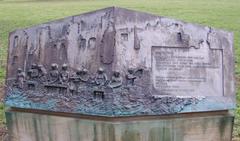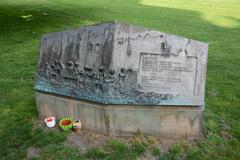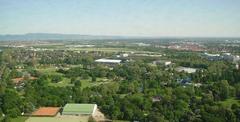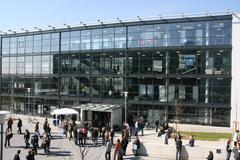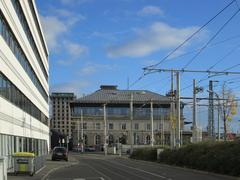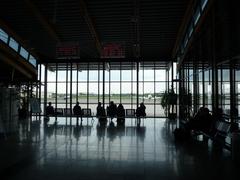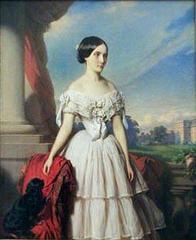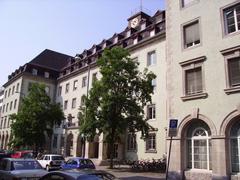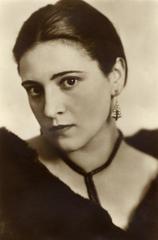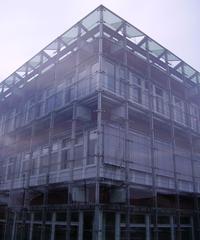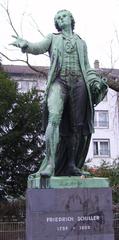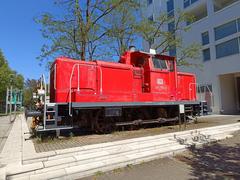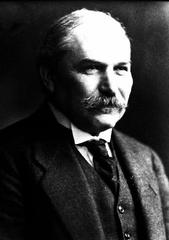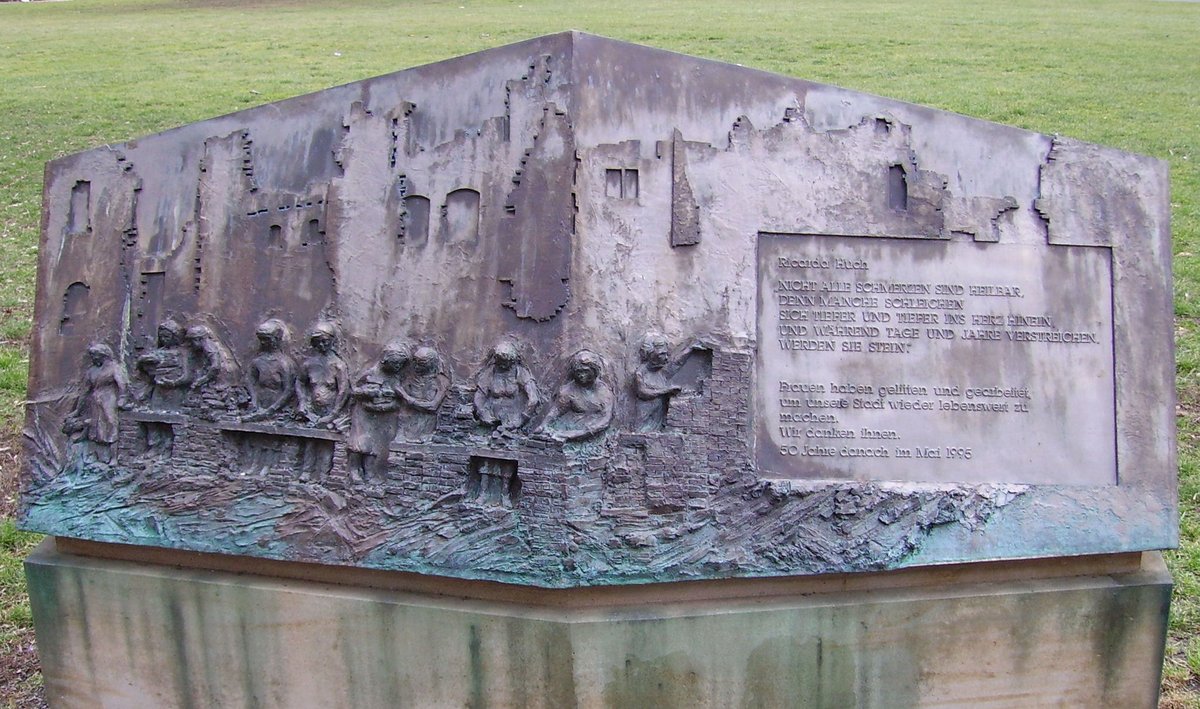
Trümmerfrauen Memorial Mannheim: Visitor Guide, History, and Practical Information
Date: 14/06/2025
Introduction
The Trümmerfrauen Memorial in Mannheim stands as a moving tribute to the “rubble women”—the women who played a critical role in the physical and social rebuilding of German cities devastated by World War II. This memorial not only honors their immense contributions but also invites reflection on the complexities of postwar recovery, memory, and the shifting narratives that have shaped public understanding of the Trümmerfrauen. Centrally located and accessible free of charge year-round, the memorial offers visitors a unique insight into Mannheim’s—and Germany’s—postwar transformation. This guide provides detailed historical context, practical visitor information, travel tips, and answers to frequently asked questions, drawing from reliable sources to enrich your experience.
Historical Background: The Trümmerfrauen
The term Trümmerfrauen (“rubble women”) refers to the women who, after World War II, were involved in clearing rubble and reconstructing cities across Germany and Austria. The devastation was staggering: out of 16 million homes in 62 German cities, 3.6 million were destroyed and another 4 million damaged, leaving approximately 7.5 million people homeless and generating around 500 million cubic meters of rubble (Wikipedia). In cities like Hamburg, half the housing stock was destroyed; in Berlin, only about a quarter of the city remained undamaged (War History Online).
With many men killed, missing, or held as prisoners of war, the burden of clearing debris and salvaging reusable materials often fell to women. The work was physically exhausting and hazardous, but it was essential for the nation’s recovery (Wikipedia).
The Reality Behind the Myth
While the Trümmerfrauen have become iconic symbols of resilience and collective effort in Germany, historical research indicates that their story is more complex. For decades, the prevailing narrative was that large numbers of women volunteered for this work out of patriotic duty. However, studies by historians such as Leonie Treber reveal that the actual number of women involved was relatively small in comparison to the total female population, and much of the work was performed under compulsion as part of Notstandsarbeiten (emergency work programs) rather than as voluntary service (War History Online). In Berlin, for example, only about 60,000 women participated, less than 5% of the city’s female population at the time. Much of the labor was stigmatized and associated with hardship and necessity (OpenLearn).
Evolution of the Trümmerfrauen Narrative
The image of the Trümmerfrau evolved into a national myth in the postwar decades. In West Germany, the narrative was initially recognized through awards and memorials, but soon faded as the focus shifted to economic recovery and the reestablishment of traditional gender roles. In East Germany, the Trümmerfrau was celebrated as a model of socialist female strength and independence (Wikipedia; OpenLearn). In the 1980s, renewed interest in women’s history and the demands of older generations brought the Trümmerfrauen back into public memory across Germany, often through commemorations and public debates (Planet Wissen).
The Trümmerfrauen Memorial in Mannheim
Artistic Features and Symbolism
The Trümmerfrauen Memorial in Mannheim is a bronze relief by sculptors Maritta Kaltenborn and Waltraud Suckow, officially inaugurated in 1995 to mark the 50th anniversary of the end of World War II (Flickr). The memorial depicts women actively engaged in clearing rubble, emphasizing both collective effort and individual strength. Its central location near landmarks such as the Jesuit Church and the Reiss Engelhorn Museum makes it easily accessible and a prominent part of Mannheim’s historical landscape (Mapcarta).
The bronze medium and expressive figures symbolize the endurance and transformation that characterized both the physical rebuilding of Mannheim and the shifting societal roles of women during this period.
Practical Visitor Information
Location and Accessibility
- Address: Centrally located, near major civic spaces and historical landmarks. For the exact location, consult Mannheim Tourist Information or Wikimedia Commons.
- Access: Easily reachable by tram, bus, bike, or on foot. Parking garages available nearby; city center is pedestrian-friendly and bicycle-accessible.
Opening Hours and Admission
- Hours: Open 24/7 year-round; as an outdoor public monument, there are no restricted visiting hours.
- Tickets: Admission is free; no tickets required.
Accessibility
- Wheelchair Accessible: Site is on level, paved ground. Some paths may be uneven, so visitors with mobility challenges should proceed with care.
- Restrooms: No facilities at the memorial itself; public restrooms are available in nearby parks, shopping centers, or cafes.
Travel Tips
- Best time to visit: Spring and summer are ideal for pleasant weather and photography; early mornings and late afternoons offer the best light and quieter atmosphere.
- Combine with other sites: The memorial is close to other attractions like Mannheim Palace, the Water Tower (Wasserturm), Kunsthalle Mannheim, and the Reiss-Engelhorn Museums.
- Guided tours: While there are no dedicated tours for the memorial, it is often included in broader historical or architectural tours of Mannheim (Mannheim Tourist Information).
- Special events: Commemorative ceremonies may take place on significant dates such as the end of World War II anniversary or International Women’s Day.
Visitor Experience and Recommendations
- Reflection: The site is designed for contemplation. Take time to observe the relief, read any plaques, and connect with the historical narrative.
- Photography: Allowed and encouraged. The memorial’s details are best captured in natural daylight.
- Educational value: Suitable for all ages; a valuable stop for families, school groups, or anyone interested in history and memory.
Contested Memory: Debates and Critiques
While the Trümmerfrauen Memorial honors the women who participated in postwar rebuilding, it also serves as a focal point for ongoing debates about the accuracy and implications of the Trümmerfrau narrative. Key issues include:
- Scale of participation: Women’s involvement varied greatly by city and region; in many cases, men and professional workers predominated (Amusing Planet).
- Voluntariness: Much of the labor was compulsory or motivated by necessity, not solely by patriotism (REM Mannheim).
- Myth vs. reality: The idealized image of the Trümmerfrau has served political and social purposes and sometimes overshadows the more nuanced historical reality (DW).
- Gender and memory: Focusing primarily on women can obscure the contributions of men, forced laborers, and other groups (Historisches Lexikon Bayerns).
Frequently Asked Questions (FAQ)
Q: What are the visiting hours for the Trümmerfrauen Memorial?
A: The memorial is outdoors and accessible 24 hours a day, year-round.
Q: Is there an entrance fee?
A: No, visiting the memorial is free.
Q: Are guided tours available?
A: While there are no dedicated tours for the memorial, it is included in many general walking tours. Check with Mannheim Tourist Information for options.
Q: Is the memorial accessible for visitors with disabilities?
A: Yes, the site is wheelchair accessible, though some paths may be uneven.
Q: What is the best way to reach the memorial?
A: Use the city’s tram or bus network, or walk from the city center.
Q: Are there restroom facilities nearby?
A: Public restrooms are available in nearby parks, shopping centers, and cafes.
Key Facts and Figures
- Estimated rubble generated in Germany after WWII: 500 million cubic meters (Wikipedia)
- Homes destroyed: 3.6 million; homes damaged: 4 million
- Homeless population: 7.5 million
- Women involved in Berlin: About 60,000 (less than 5% of the female population)
- Nature of work: Often compulsory, physically demanding, and hazardous
- Recognition: Early honors included the Bundesverdienstkreuz and commemorative statues; later, the narrative became more mythologized and politicized
Nearby Attractions
- Mannheim Palace: One of Europe’s largest Baroque palaces
- Luisenpark: Renowned for its gardens and recreational areas
- Kunsthalle Mannheim: Features modern and contemporary art
- Jesuit Church: Baroque architecture near the memorial
- Reiss-Engelhorn Museums: Exhibitions on local history and culture
Sustainability and Responsible Tourism
Support Mannheim’s green initiatives by using public transport, cycling, and ensuring you leave no waste at the memorial site.
Languages and Communication
Plaques are primarily in German. English is widely spoken in tourist venues; translation apps or phrasebooks may be helpful.
Conclusion
A visit to the Trümmerfrauen Memorial in Mannheim offers a meaningful encounter with Germany’s postwar history and the resilience of its people. The memorial is not only a place for remembrance but also for critical engagement with the narratives that shape collective memory. Its central location, free access, and proximity to other landmarks make it an essential destination for history enthusiasts, families, and cultural travelers alike.
For curated tours and the latest visitor information, download the Audiala app and follow us on social media for updates and travel inspiration. To further explore Germany’s postwar heritage, consult the resources listed below.
References and Further Information
- Wikipedia: Trümmerfrau
- Myth of the Trümmerfrau – War History Online
- Trümmerfrauen: Contested Memories – OpenLearn
- Trümmerfrauen – Planet Wissen
- Flickr: Visiting the Trümmerfrauen Memorial in Mannheim
- Mannheim Tourist Information
- DW: Dismantling the German Myth of Trümmerfrauen
- REM Mannheim: Trümmerfrauen 1946 von Robert Häusser
- Liberation Route: Trümmerfrau Denkmal
- Historisches Lexikon Bayerns: Trümmerfrauen
- Amusing Planet: Trümmerfrauen – Women Who Helped Rebuild Germany
- Wikimedia Commons: Trümmerfrauen-Denkmal (Mannheim)
